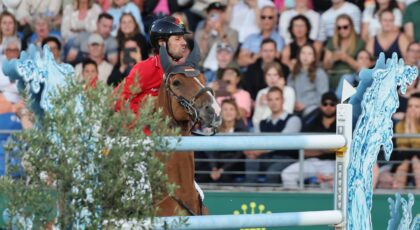The 1950s weren’t a kind time to be a woman in eventing.
It took one with single-mindedness and determination to find opportunities and success in the sport.
Enter Sheila Wilcox, a pretty, feisty young woman who, at the tender age of 21, claimed the first of three consecutive wins at Badminton in 1957, 1958 and 1959.
It’s a record that no rider has been able to touch in over 60 years.
Wilcox’s first two Badminton victories came aboard an Arab cross named High and Mighty, who she bought when she was 16 years old and trained herself. In 1957, the pair lead the event from start to finish. The following year, they captured the title with a 22 point lead after dressage that ultimately widened to 47 points—the widest margin win at the famed event to date.
Wilcox returned in 1959 with a new and inexperienced mount, seven year old Airs and Graces, to win Badminton an unprecedented third consecutive time.
“The men were horrified that a girl took over,” she said, reflecting back on those famous wins in an interview with Chris Stafford and the Equestrian Legends Series podcast. “It was very nasty.”
While her riding caught the eye of the British team selector, Wilcox wasn’t able to claim a spot on the teams for the 1956 or 1960 Games as women weren’t allowed to compete in eventing at the Olympics at that time. She did, however, represent Britain at the 1958 European Championships in Copenhagen with High and Mighty, winning both team and individual gold to become the first woman ever to win the Europeans.
It wasn’t just riding where Wilcox had talent. In 1958, at the age of 22, she published her first book Three Days Running, which would become a classic text for three-day eventers.

Despite growing up in an unhorsey, suburban family, Wilcox had a knack for spotting a diamond in the rough and turning unremarkable horses into champions.
“I used to buy something and people would say, ‘What’s this one? It’s a really good horse!’ And I would say, ‘That’s the one you saw the other day,’” she told Stafford. “I was very good at looking at a horse other people would turn their nose up at and saying, ‘Hmm, I can do something with that.’”
Unfortunately, Wilcox’s eventing career was cut short following a fall at the 1971 Tidworth Horse Trials that left her partially paralyzed. While many would be reluctant to get back in the saddle, Wilcox switched to dressage and rode at the Grand Prix level.
The pioneering Wilcox passed away in 2017 at the age of 81 and is remembered around the world as one of the riders who paved the way for women in eventing.
Hear more about Sheila Wilcox’s remarkable journey on the Equestrian Legends Series podcast:


 April 20, 2020
April 20, 2020 


























